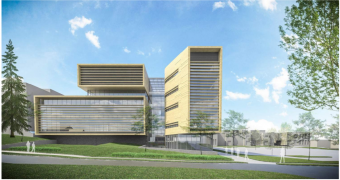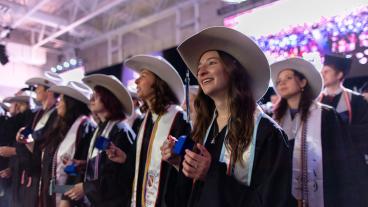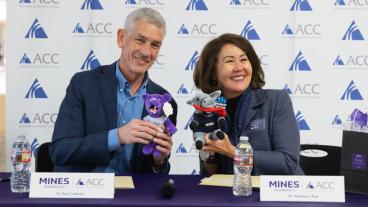Colorado School of Mines moving forward with plans for Subsurface Frontiers building

Colorado School of Mines plans to break ground early next year on a new state-of-the-art research and teaching facility that will bring Mines faculty and U.S. Geological Survey scientists together to tackle critical challenges related to the energy transition, water and mineral resources, subsurface urban infrastructure and more.
The Subsurface Frontiers building marks a major milestone in the continuing long-term partnership between Mines and USGS announced in late 2018. When the 180,000-square-foot facility opens in 2022, more than 150 USGS scientists and their minerals research labs will relocate to the Mines campus, where they will work alongside Mines professors and students with expertise in geology, geophysics, hydrology, mineral economics and public policy.
“We are so excited to be able to share more details about the Subsurface Frontiers building, the most significant research facility that Mines has ever built,” said Kirsten Volpi, executive vice president and chief operating officer of Colorado School of Mines. “This building and the partnership with USGS is a once-in-a-lifetime opportunity to elevate Mines to a new level. We're already a top institution for subsurface engineering and science, and we can take another big step with this partnership.”
Subsurface Frontiers will be located on the Mines campus at 18th and Cheyenne streets, on the site of a parking lot that currently serves the existing USGS Geologic Hazards Science Center.
Global architecture firm Perkins + Will has designed the modern, $140 million building, which will feature cutting-edge laboratory space, flexible classrooms, a high-performance computing center, large outdoor courtyard and a cafe. Funding for the building will be multifaceted, with support from private donors, the state of Colorado, student fees and rental income.
As part of the project, Mines also plans to build an incubator and 760-stall parking structure at the corner of 18th and Washington streets, to accommodate both the USGS employees moving to campus and additional student and employee parking.
A large number of the USGS scientists moving to campus will become affiliated faculty and contribute directly to the educational mission of Mines, said John Bradford, Vice Provost for Global Initiatives and Dean of Earth Resources and Environmental Programs at Mines.
Among the Mines groups that will call the building home are the Critical Materials Institute, Payne Institute for Public Policy, Space Resources, Center for Mineral Resources Science, Hydrologic Science and Engineering, and Geophysics.
“All of these components are critical for our big vision of building a subsurface modeling platform that is easily accessible and continuously updated for use on all sorts of problems,” Bradford said. “Imagine if, from your web browser or smart phone, instead of zooming from way out in space to look at your house, you could start peeling back the layers of the Earth and look into the subsurface.”
“Not only will the Subsurface Frontiers building allow Mines to further achieve our institutional goals to be the go-to place for education, research and technology development related to the Earth, but it will also support the ambitious goals of the state of Colorado to build on its low-carbon energy future,” Bradford said. “Even though it often appears that renewable energy production, distribution and storage is all above-ground, the Earth’s subsurface is critical to achieving this goal – whether it’s the rare and critical minerals needed to make the technologies that convert sunlight, wind and geothermal into energy, or the safe distribution and storage of that energy.”
Mines has begun holding neighborhood meetings to discuss design updates and address concerns about the project. The next meetings will be held from 6-7 p.m. on Nov. 13 at the Mines Park Community Center II, 2001 Infinity Circle, and on Dec. 11 from 6-7 p.m. in Student Center Ballroom D.




